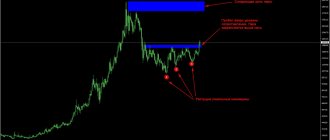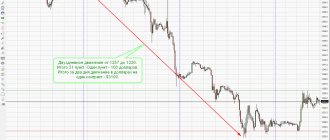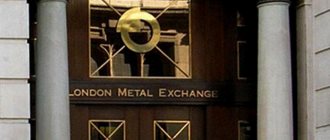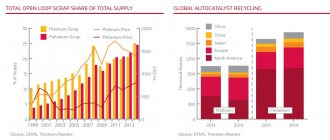In terms of money turnover, the Forex market has had no equal for a very long time. This attracts a lot of speculators, the number of transactions of which significantly exceeds the number of ordinary financial transactions carried out for commercial purposes. Therefore, Forex is often operated by large banks, hedge funds and large financial institutions, which, by injecting large sums, can have a short-term impact on the price and benefit greatly from this. At the same time, it would seem that currency fixing should be impossible, but as periodic high-profile scandals show, this is absolutely not the case.
The term itself, thanks to which few people do not know what the London fixing is today, arose at a time when the Rockefeller family controlled world gold prices, and this happened for almost a century, starting in 1919. Actually, the London fixing stopped functioning quite recently; gold prices stopped being fixed on March 20, 2015. Until this time, the most authoritative market participants allowed themselves to meet and jointly place large transactions for purchase and sale, which kept the price in the required range.
The problem of currency fixing
Having understood what the London fixing was, which lasted almost a century, for precious metals, it is worth moving on to its new reincarnation, but in the financial market. So, every day on the London Stock Exchange at 4 pm the rates of major currencies (21 trading instruments) are fixed, which act as a certain reference point.
Well-known stock news provider Reuters calls them benchmark rates. The essence of this phenomenon is that during one minute - half a minute before and half a minute after 4 o'clock in the afternoon, the total amount of orders entering the market for the purchase and sale of each currency determines its average value, which is then used to evaluate investments in millions and even billions dollars, owned by large funds.
How the price of gold is manipulated during the London Fixing
There was a time when the slightest mention of gold manipulation in the "respectable" media was enough to earn you the eternal label of a conspiracy theorist with bad breath living in a backyard bunker. This roughly coincides with a time when manipulation of (the benchmark interest rate) Libor, forex, mortgages and bond markets was considered unthinkable; when high-frequency traders were believed to “bring liquidity”; when they said that there was no Fed manipulation in the stock market; and when the ever-puzzled media, always eager to fit “complex” financial topics into the framework set by the self-interested ruling elite, did not dare to ask questions. Fortunately, everything has changed in the last few years, to such an extent that even the bastions of “respect”, although 3-5 years late, are finally not only raising the question of gold market manipulation, but also providing real answers.
For example, Bloomberg.
The topic of manipulation of the gold market during the morning price setting in London is not new for ZeroHedge: indeed, we have long discussed both the historical basis and the meaning of the London gold rate, as well as the interesting arbitrage available to traders on the difference in morning and afternoon prices. That is why we are glad that none other than Bloomberg decided to explain to everyone and name all the ways of manipulation in this one aspect of gold trading.
Start in Bloomberg:
Every working day in London, five banks jointly set the price of gold, following a tradition begun in 1919. Now dealers and economists say the knowledge gained from these roll calls may give some traders an unfair advantage when buying and selling precious metals. This reference price (London fix) is used by mining companies, jewelers and central banks to buy, sell and value metal. It is published twice daily following telephone conversations between Barclays Plc, Deutsche Bank AG, Bank of Nova Scotia, HSBC Holdings Plc and Societe Generale SA.
The history of the London fixing began in September 1919, less than a year after the end of the First World War, when representatives of five stock dealers met at Rothschild's office in St. Swithin's Lane in London's financial district. Fixing was suspended for 15 years until 1939. Although Rothschild has withdrawn his involvement since 2004, and negotiations are now conducted over the phone rather than in the bank's wood-paneled room, the process remains largely the same.
This is widely known. It is also known that any process involving five banks who sit (until recently literally) and exchange information using hidden methods (such as telephone) according to a set schedule, implying a period of absence of publicly available information, although limited, with lack of immediate market reaction, can and will be used in the game. “Traders involved in this price discovery process have, for a short period of time, information that exceeds the amount of information that other people have,” said Thorsten Polleit, chief economist at brokerage firm Degussa Goldhandel GmbH and former Barclays economist . “This is a big disadvantage of the London gold price fixing.”
There are other disadvantages.
Participants in the London roll call can tell within a minute whether the price of gold is rising or falling based on whether there are a large number of net buyers or sellers after the first round, according to traders, researchers and investors surveyed by Bloomberg News. This parameter gives stock dealers and others the information to bet with a high degree of confidence on the direction of the market just minutes before a bet is announced, they say.
Yes, most people also know about creating a wide impulse and the effect of the ignition key. At least those who never believed the cliche that, unlike other assets, gold is somehow protected from manipulation.
“Information trickles down from the five banks to their customers and then into the broader market,” Andrew Caminschi , , . He is the co-author of an article on trading prongs during the London gold fixing, published 09/02/2013. “In a world where trading advantage is measured in milliseconds, this has some value.”
Yes, it is reasonable to speak out speculatively. You can't attack prematurely before, as with Libor, it turns out that everyone is in on it.
There is no evidence of gold dealers manipulating, or working together to rig prices, as the Libor exchange dealers did. But economists and researchers all argue that this method of setting prices is outdated, vulnerable to abuse, and lacks direct regulatory oversight. "This is one of the most disturbing fixes I've ever seen," said Rosa Abrantes - Metz , a professor at New York University's Stern School of Business whose 2008 paper "Libor Manipulation? " (Libor Manipulation) contributed to the start of a global investigation. “It is controlled by a handful of firms with a direct financial interest in controlling the pricing process, and with virtually no oversight—pricing is based on the exchange of information in a private telephone discussion.”
If we are not mistaken, there was no evidence of conspiracy to manipulate the Libor rate before. And since the London gold fixing clique is much smaller than the banks involved in determining Libor, it is much easier to keep intentions within a small group. But most people know all this too.
As does the fact that, when asked to comment, “representatives from Barclays, Deutsche Bank, HSBC and Societe Generale declined to say anything about the London fixing or regulators' research, as did FCA spokesman Chris Hamilton. Hamilton and CFTC representative Steve Adamske . _ A spokesperson for Bank of Nova Scotia wrote in an email that the Toronto-based company has a "deeply ingrained culture of compliance and a motivation to continually look for ways to improve existing processes and practices."
Bloomberg then moves on to discuss the details of manipulation of the gold price, first by the fixing banks, then by their “friends and neighbors,” as news of the fixing process emerges.
At the beginning of the call, the designated chairman—a position in which five banks rotate each year—presents a figure close to the current spot price of an ounce of gold in dollars. Firms then announce how many bars of the metal they wish to buy or sell at that price, based on orders from customers and their own balance sheets.
If there are more buyers than sellers, the starting price is raised and the process begins again. Negotiations continue until the difference between the volumes of purchases and sales is no more than 50 bars, or 620 kg. This procedure is carried out twice a day, at 10.30 am and 3 pm in London. Prices are set in dollars, pounds and euros. Similar criteria apply to silver, platinum and palladium.
Traders broadcast changes in supply and demand to clients during these negotiations and receive new orders to buy or sell when the price changes, which is published on the London Gold Market Fixing website.
...but this time the manipulations are not limited to a purely theoretical plane, there is actual evidence of fixing leaks, presented on the basis of academic research:
Kaminschi and University of Western Australia accounting and finance professor Richard Heaney analyzed two of the most widely traded gold derivatives: Comex gold futures and State Street Corp.'s SPDR Gold Trust, a gold-backed exchange-traded product . , the most widely traded on the exchange from 2007 to 2012.
Kaminschi and Heaney found that after calls began at 3:01 p.m., trading volume jumped 47.8% above the average level in the 20-minute period before the fixing began and remained 20% higher in the next six minutes. The same picture was recorded in trading in SPDR Gold Trust shares.
“Intuitively, we would expect a peak in trading volumes after the input to the market” when the final result is released, Kaminschi and Heaney wrote in “Fixing a Leaky Fixing: Short-Term Market.” Reactions to the London PM Gold Price Fixing). “In our analysis, we observed aggregation of trading immediately after the fixing began.”
The researchers also assessed how well movements in gold derivatives predicted the final fixing price. Between 2 o'clock 59 min. pm and 3 o'clock. The direction of futures contracts coincided with the direction of fixing for almost half of this time interval.
From 3:01 a.m. The success rate jumped to 69.9%, rising to 80% within five minutes. On days when the price of an ounce of gold increased by more than $3, gold futures successfully predicted the final fixing outcome more than 9 out of 10 times. “Trading not only quite accurately predicts the direction of the fixing. The more money is made on a larger price change, the more accurate the trades become, write Kaminschi and Heavey. “This leads us to believe that information from the fixing is leaking to public trading.”
Come on, 9 out of 10 cases hardly says anything about violations. After all, JP Morgan lost... trading days for all of 2013 and no one cares. So if flipping a coin comes up on heads 200 times in a row, and regulators consider this to be normal, then of course the Futures Trading Commission will not find anything strange in the little manipulations with gold here and there. In manipulations, which, as stated earlier, do not exist. But everyone knows this too.
Leaving cynicism aside, declaring that this obviously staged trial is not such is the height of idiocy. This cannot be called criminal fraud until no one is caught red-handed by law enforcement agencies that are not actually involved in this scheme. That's why we are confident that regulators will follow this path. And this is also widely known. There are also known benefits for traders who abuse the London fixing:
The advantage for derivatives traders is clear: a dealer who buys 500 gold futures contracts at 3 pm, knowing that the fixing will be higher, can make $200,000 for his firm if the price moves $4 (the average change in the sample). Although the full value of the 500 contracts is $60 million, traders can buy on margin, a process that involves borrowing and requires less capital to bet. On a typical trading day , about 4,500 futures contracts are traded between 3 and 3:15 p.m., Kaminsci and Heavey write
Finally, it is undoubtedly known that the principle of setting a price using the “London fixing” is very simple in our time of cutting-edge technology, and requires several minutes for real implementation.
Abrantes-Metz, who helped the International Organization of Securities Commissions (Iosco) formulate the recommendations, said the downsides of gold fixing could go beyond giving firms and clients access to proprietary information.
“These banks are very much incentivized to have a say in setting the benchmark price based on their trading positions, and there is virtually no check ,” she said.
Abrantes-Metz said gold fixing should be replaced by calculating a benchmark price based on current trading in a market that traded $19.6 trillion in precious metals last year, according to New York-based research firm CPM Group. “There is no barrier to collecting data on current spot gold prices based on exchange conditions or electronic trading,” she said. “This data is more than enough.”
That is why there will be no changes. It's sad, but this is also well known.
So, did Bloomberg simply collect almost everything a priori known in one detailed article? It turns out not: we learned one thing.
London Gold Market Fixing Ltd., controlled by five fixed member banks, has no permanent employees. ' call was answered by 68-year-old Douglas Beadle , a former Rothschild banker who acts as a consultant to the company from his home in the town of Caterham, near London . Beadle declined to comment on the price-setting process.
Every day we learn something new. By the way, this is the same Douglas Beadle who, until March 2010, acted as a consultant to the London Bullion Market Association ( LBMA ) and from the very beginning participated in the project to find suitable scales for electronic weighing of gold .
Trader collusion
Such London fixing today creates ideal conditions for collusion among traders representing the interests of large market participants. And the wildest thing is that such a conspiracy cannot be called illegal, although that is exactly what it is, and it is simply impossible to hide its periodic manifestations on the Forex market.
The mechanism of this enormous scheme is that such traders deliberately hold large transactions to the time of the London fixing and use this knowledge to their advantage. Such events sometimes occur on large stock exchanges, but such insider trading does not comply with the regulations and can result in serious punishment. However, Forex is not a regulated market, which means that no one can officially make claims or punish for the use of forward transactions.
London gold market conditions
The traditions of gold trading in London have been established for a long time and are observed to this day.
All gold entering this market must meet the standards of the so-called “good delivery”:
- The gold sample must be such that it contains at least 995 parts of pure gold with the addition of no more than 5 parts of impurities. Pure gold means 999.9 fine gold.
- The weight of a gold bar must be no less than 350 and no more than 430 troy ounces.
- The ingot must be marked and serial numbered from one of 49 refining and marking plants that have proven themselves to be reliable suppliers. If the marking and number are missing, then the ingot must be accompanied by a certificate containing the sample and number and certified by one of 49 enterprises.
The buyer cannot dictate terms that do not meet the established standards. At the same time, he may express a desire to purchase metal of a certain standard and the market may meet him halfway.
End justifies the means
The main idea behind the activities of many private traders and investors in the Forex market is the following: the price finds its natural position under the influence of natural supply and demand, and individual traders cannot influence the situation, since the market is so huge that the actions of individuals are almost invisible. But by using collusion before currency fixing, traders provide themselves with the conditions under which this becomes possible.
If there was no collusion, a trader who initially made a trade to buy the dollar against the euro in order to make money for himself would still be at risk, since it was possible that another major player would enter the market who could buy the euro against the dollar and balance the trade for sale. Therefore, we have to resort to collusion, which allows us to jointly move the price of the currency in the desired direction in a short period of time.
How much do auction participants pay for precious metals?
Auction participants may be interested in a variety of precious metals: gold, palladium, silver, platinum. London fixing allows you to purchase an asset at the most favorable price, as well as sell it. When the auction is completed, its participants pay for the asset in accordance with the existing applications. The metal seller receives a settlement at a fixed cost. Asset buyers pay, in addition to the fixed price, 25 cents on top of every dollar. Silver buyers pay a similar premium of 0.0025 cents. Platinum buyers pay the fixing price plus one more dollar. The gold rate - the London fixing determines it through trading - is immediately announced to international news agencies, which distribute it in all directions. The daily fixing reflects the picture most effectively, since during its implementation the markets of America, Africa, the Middle East and Europe are in full swing. The daily fix serves as a guideline for all banks in the world in a variety of countries.
Currency fixing scandal
If everyone knew about the London Rockefeller fixing for gold and it acted as a guide for other exchange participants, then manipulations with the currency before setting benchmark rates were first noticed in 2008. This was the time when the financial crisis broke out in the United States, which began with the bankruptcy of a large construction company. At this point, several financial analysts noticed a strange coincidence in the actions of some of the major banks.
But the main scandal occurred in 2013, when Bloomberg experts identified a pattern of actions by large market participants shortly before the currency fixing on the London Stock Exchange. They found that for two years there was a conspiracy, the purpose of which was to provoke a large jump in prices on the last trading day of the month. Moreover, after a sharp price shift in one direction, it was then followed by an equally unexpected return. This trend was immediately evident in fourteen currency instruments.
Here you need to pay attention to the fact that the last trading day is a very important reference point, since the value of currencies for this period allows you to evaluate the assets of large pension and hedge funds.
A rather interesting fact was that after the scandal broke, it became known that the management of the Bank of England knew about such a trading strategy with data exchange. Moreover, its experts were able to recognize such actions back in 2006 and, according to members of the management of the Bank of England, they could not do anything, since such a strategy normalizes liquidity in the market and does not contradict the mechanisms of Forex, which in fact is not a regulated trading platform.
Story
On September 12, 1919 at 11:00 am the first gold fixing took place in London, the participants of which were the five largest traders and producers of gold bullion. Initially, the “golden five” included the following companies:
- "N. M. Rothschild & Sons" (eng. NM Rothschild & Sons);
- Mocatta & Goldsmid;
- "Pixley & Abell" (eng. Pixley & Abell);
- Samuel Montague & Co. (eng. Samuel Montagu & Co);
- Sharps Wilkins
During the first fixing, the price of gold per troy ounce was set at 4 pounds 18 shillings and 9 pence. In New York, the price at that time was $20.67 per troy ounce. Initially, participants in the gold fixing communicated and set prices by telephone, but then began to regularly meet in the office of the Rothschild company.
During the Second World War and in the first years after its end, from 1939 to 1954, the London gold market did not function and there was no gold fixing.
Since 2004, fixing has been carried out using a telecommunications conference system.
In subsequent years, changes occurred in the composition of the “golden five” members participating in the fixing. The Rothschild financial group withdrew from gold trading and, accordingly, gold fixing and since 2004 its place was taken by Barclays Capital Bank. The place was taken by the Scotia-Mocatta company, which is the successor to the Mocatta company and part of the Bank of Nova Scotia. The place of Pixley & Abell was taken by Deutsche Bank, the owner of Sharps Pixley, which was once formed by the merger of Pixley & Abell and Sharps Wilkins. The place of Samuel Montague & Co was taken by HSBC bank, which is the owner of this company at present. And finally, another major transnational bank, Société Générale, took fifth place in the group of companies involved in gold fixing.
New trends
However, large regulators who are trying to maintain a certain order in Forex could not help but pay attention to such a blatant fact of insider knowledge. In this regard, individual regulatory organizations brought charges against traders on whose behalf these “illegal” transactions were executed. Among the organizations that brought forward the accusation are:
- FCA (Financial Conduct Authority) UK;
- Swiss Competition Commission;
- United States Department of Justice;
- special commission of the ECB.
However, the charges brought against the traders only led to their dismissal from their positions. Nothing is known about more serious punishments. In order to assess the prospects of the working scheme, it is worth noting that among the accused trading managers were employees of Barclays, Citigroup, Deutsche Bank and other largest and respected world banks.
Bottom line
So, on the one hand, currency fixing on the London Stock Exchange is needed by the largest participants themselves, since the valuation of assets and some other funds is still very important, since there must be benchmarks by which some kind of comparative analysis can be done. On the other hand, the disclosed schemes show that the London fixing is not as objective as everyone thought it was. This means that the valuations of some funds and financial institutions may, to put it mildly, be misleading.
In addition, such scandals clearly show that Forex is the most opaque and unregulated market in the world, where large financial institutions can afford dishonest manipulations without any risks, since the maximum punishment for detected actions was the removal of officials who directly concluded transactions, but not affected the very leadership of large banks and funds, which, without a doubt, initiated the creation of a conspiracy to obtain large profits or pursue other interests, for example, inflating the value of assets.
Fixing and its participants
London fixing is a process of fixing the price of precious metals, which has certain similarities to an auction. The subject of the auction is Good Delivery bars, which weigh 400 troy ounces. Five largest banks are participating in a kind of auction:
- Deutsche Bank.
- Société Générale.
- HSBC.
- Scotia Mocatta.
- Barclays Capital.
Investors can also take part in the auction, but only through dealers, represented by the banks mentioned above. Representatives of financial institutions communicate with their banks during the process, and they, in turn, inform their clients in real time. The London gold fixing begins with the chairman announcing the price of the metal, which is the most relevant at the moment. This cost is announced to auction participants through dealers. In the opposite direction, information is received about how many sales and purchases there are in accordance with the specified value of the asset.
Situation in Russia
Today, in the conditions of an unstable economic situation in Russia, fixing and its indicators have begun to play a big role for domestic investors. The depreciation of the ruble leads to people showing more and more interest in the gold asset, which receives support due to the systematic depreciation of the national currency.
By the end of 2014, the purchase of precious metal could be carried out at a price of 3,055 rubles. It was sold at a price of 1,465 rubles. This course is offered by the largest bank in the country - Sberbank. As demand from Russian residents for precious metals increases, quotes on exchanges in pairs with the ruble are growing. The trend lasts for a long time, which allows the asset price to be set an order of magnitude higher than that determined by the fixing procedure. The difference between the fixing indicators and the actual price available to private investors is the income of dealers who carry out transactions with the asset directly at the time of the fix.











